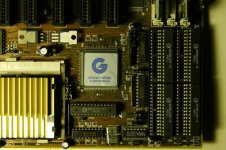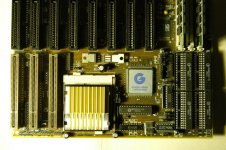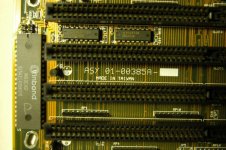Hello All
I am doing some troubleshooting to make sure none of the instrument boards have a short. The instrument consists of 6 boards: A DSP processor board with a AT&T DSP16A chip for each pair of channels plus the memory for the instrument, 4 acquisition cards with two channels each, and a another board used for control and signal generation. All 6 cards are long as the one in the picture. The original custom box also needed a slot for the LCD video card and a disk drive controller (8 total) The systems are used in a portable mode, so a seperate monitor is a chore. I am not sure what roll the 486 plays- it is not involved in data acquisition or computing, but is involved with the display. When looking at data that requires displaying a lot of data points on eight channels, the instrument never misses a beat but the display will be updated very slowly. Motherboard is 8.625 inches by 10. One of the systems, which works the best, has a Genoa 486-66 VLG TurboExpress, but it is a couple of years older than the board in the photo.
I am doing some troubleshooting to make sure none of the instrument boards have a short. The instrument consists of 6 boards: A DSP processor board with a AT&T DSP16A chip for each pair of channels plus the memory for the instrument, 4 acquisition cards with two channels each, and a another board used for control and signal generation. All 6 cards are long as the one in the picture. The original custom box also needed a slot for the LCD video card and a disk drive controller (8 total) The systems are used in a portable mode, so a seperate monitor is a chore. I am not sure what roll the 486 plays- it is not involved in data acquisition or computing, but is involved with the display. When looking at data that requires displaying a lot of data points on eight channels, the instrument never misses a beat but the display will be updated very slowly. Motherboard is 8.625 inches by 10. One of the systems, which works the best, has a Genoa 486-66 VLG TurboExpress, but it is a couple of years older than the board in the photo.




